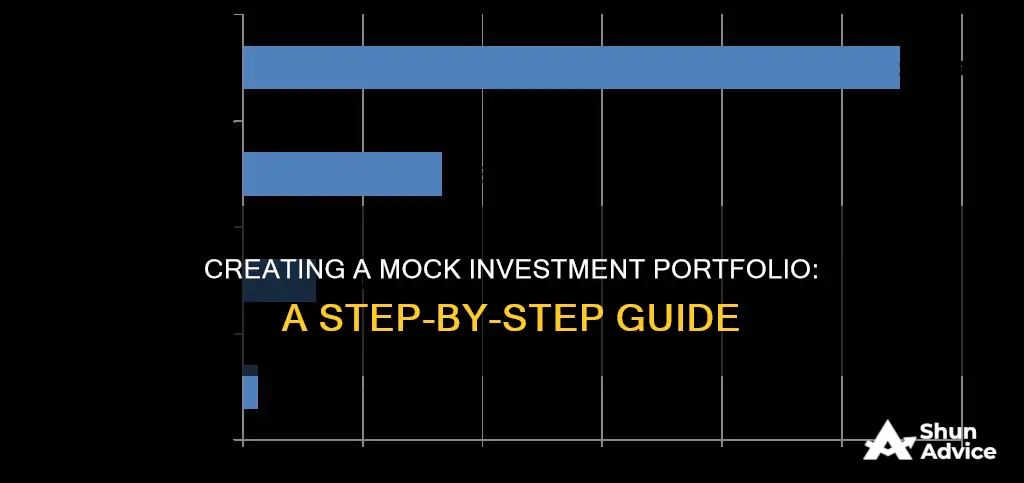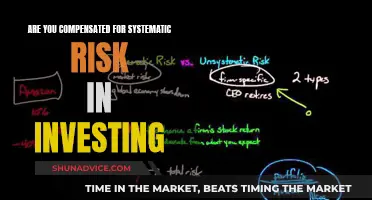
A mock investment portfolio is a risk-free way to get started with investing. It allows you to simulate investing in stocks, ETFs, mutual funds, and more, without putting any real money on the line. You can create a mock portfolio on paper or online, using fake money to invest in a selection of assets and track their performance. This is a great way to get familiar with market research, financial websites, and investing concepts such as diversification, risk, and return. By creating a mock portfolio, you can make investment decisions, monitor their performance, and adjust your strategy without any financial risk. This is a valuable tool for beginners to gain experience and build confidence before investing their own money.
| Characteristics | Values |
|---|---|
| Purpose | To learn about investing without the risk of losing money |
| Investment types | Stocks, ETFs, Mutual funds, Bonds, Cryptocurrencies |
| Investment goals | Short-term, long-term, retirement, education, etc. |
| Investment research | Company news, rumors, market trends, financial websites |
| Portfolio creation | Yahoo Finance, Microsoft Excel, Google Sheets, Mock Portfolio websites |
| Portfolio characteristics | Diversified, risk-adjusted, aligned with goals |
| Portfolio tracking | Monitor performance, adjust as needed, aim to beat the market |
What You'll Learn

Discuss investment goals
When creating a mock investment portfolio, it is important to first discuss and identify your investment goals. This is a crucial step, as it will guide your investment decisions and strategies. Here are some key considerations to help you define your investment goals:
Investment Objectives
Begin by outlining your specific objectives. Are you investing for retirement, saving for a down payment on a house, or simply aiming to grow your wealth? For younger investors, the goals might be more immediate, such as saving for a desired purchase or a car. Clearly defining your objectives will provide a sense of purpose and direction for your mock investment journey.
Time Horizon
Consider your investment time horizon, which refers to the length of time you plan to invest for. Are you investing for the short term or the long term? This will impact the types of investments you choose and the level of risk you are willing to take. For example, if you're saving for retirement, you might have a longer time horizon, whereas saving for a car might be a shorter-term goal.
Risk Tolerance
Understanding your risk tolerance is crucial. Assess how comfortable you are with the inherent ups and downs of investing. Are you willing to take on high-risk investments, or do you prefer a more conservative approach? Your risk tolerance will influence the types of investments you choose and the potential returns you can expect. Be honest with yourself, as a higher tolerance for risk might steer you towards a more aggressive portfolio, while a lower tolerance might indicate a more cautious approach.
Desired Outcomes
What are your desired outcomes from investing? Define what success looks like to you. Are you aiming for capital preservation, income generation, or capital appreciation? Do you want to beat the market, or are you satisfied with steady, long-term growth? Articulating your desired outcomes will help shape your investment strategies and the metrics you use to evaluate your mock portfolio's performance.
Liquidity Needs
Consider your cash flow needs and whether you anticipate requiring access to your investments in the short term. This will influence the level of liquidity you need in your portfolio. For example, if you might need to draw on your investments to meet regular expenses or unexpected costs, you should factor this into your goals.
Regular Review
Remember that your investment goals may evolve over time, and it's important to stay adaptable. Regularly review and reassess your goals, especially if your circumstances change. This will help ensure that your mock investment portfolio remains aligned with your objectives and that you make any necessary adjustments to stay on track.
By thoroughly discussing and considering these aspects, you will be well-prepared to define your investment goals and create a mock investment portfolio that is tailored to your specific needs and aspirations.
Wealth Management: Investment Management's Strategic Arm?
You may want to see also

Understand investment types
When creating a mock investment portfolio, it's important to understand the different types of investments available. Here are some common investment types:
- Stocks: When you buy a stock, you own a piece of the company that issues it. Stocks are typically classified based on the companies that issue them and their performance in the market. Stocks can be further categorised into equity or stock funds, which are mutual funds and ETFs that invest in a diverse mix of stocks.
- Bonds: Unlike stocks, bonds don't give you ownership rights. Instead, they represent a loan from the buyer to the issuer of the bond. Bonds are debt obligations of entities such as governments, municipalities, and corporations. When you buy a bond, you are entitled to periodic interest payments and the return of the bond's face value upon maturity.
- Mutual Funds: Mutual funds are investment vehicles that pool money from multiple investors to purchase stocks, bonds, or other assets. They are not traded on an exchange and are valued at the end of the trading day. Mutual funds can either passively track indices or be actively managed by fund managers.
- Exchange-Traded Funds (ETFs): ETFs are similar to mutual funds but trade on stock exchanges and are valued constantly throughout the trading day. ETFs also invest in a diverse mix of stocks, bonds, or other assets.
- Cash Investments: These are short-term financial instruments with high liquidity, minimal market risk, and a maturity period of less than three months. Examples include savings accounts, money market funds, and certificates of deposit (CDs).
- Real Estate: You can invest in physical property, such as residential or commercial real estate, or in companies that manage and profit from real estate, such as Real Estate Investment Trusts (REITs). REITs trade on stock exchanges and offer investors instant liquidity.
- Commodities: Commodities include metals, oil, grain, animal products, financial instruments, and currencies. They can be traded through commodity futures or ETFs.
- Cryptocurrencies: Bitcoin, Ethereum, and other cryptocurrencies have gained popularity as investment vehicles. They can be traded on specialised platforms or included in mock crypto portfolios.
- Derivatives: Derivatives derive their value from another instrument, such as a stock or index. Options contracts are a type of derivative that gives the buyer the right to buy or sell a security at a fixed price within a specific period. Derivatives often employ leverage, making them high-risk and high-reward.
It's important to note that different investment types carry different levels of risk and potential rewards. Diversifying your mock portfolio across various asset classes, such as stocks, bonds, and cash investments, can help spread out the risk. Additionally, understanding the basics of investing, such as diversification, risk, and return, will help you make more informed decisions when building your mock investment portfolio.
Building a Diversified Investment Portfolio: Strategies for Success
You may want to see also

Set up an account
Setting up an account is the first step to creating a mock investment portfolio. This can be done via a website that offers online portfolio tracking, such as Yahoo Finance, or by creating a simple spreadsheet using Microsoft Excel or Google Sheets. If you're creating a mock portfolio for a child, Yahoo Finance is a good option as it's free and easy to use.
Once you've chosen a platform, you'll need to assemble a watchlist of stocks, ETFs, mutual funds, and other investments to track. You can pick a few of your favourite companies or sectors to get started. This will give you a vested interest in tracking their performance.
If you want to take part in stock market games or competitions, you can use a platform like MockPortfolios.com. Here, you can join competitions that simulate investing in the stock market with virtual cash. For example, in the "Dow-Only Competition", you start with $2,000 in virtual cash and can only invest in the 30 stocks in the Dow Jones Industrial Average. This is a good option if you're looking for a more interactive and competitive experience.
Alternatively, you can use a virtual mock portfolio tracker like Covey, which is free and allows you to earn rewards for your virtual portfolio. You can also try Ziggma, Delta Investment Tracker, AssetDash, or Stock Rover, each offering unique features tailored to different levels of investors. These platforms provide real-time market data and tools to help you track and optimize your mock portfolio's performance.
Saving and Investing: Strategies for Future Financial Goals
You may want to see also

Diversify your portfolio
Diversifying your mock investment portfolio is a crucial step in managing investment risk and building long-term wealth. Here are some detailed steps to help you diversify your mock portfolio:
Spread the Wealth
Don't put all your mock money in one stock, one sector, or one type of investment. Consider creating your own virtual mutual fund by investing in a variety of companies you know and trust. You can invest in stocks, but also consider other options like commodities, exchange-traded funds (ETFs), and real estate investment trusts (REITs). Think globally to spread your risk and potentially increase your rewards.
Consider Index and Bond Funds
Add index funds or fixed-income funds to your mock portfolio. These funds track various indexes and can be a great long-term diversification strategy. Fixed-income solutions, in particular, can help hedge your mock portfolio against market volatility and uncertainty. Index funds often have low fees, which means more mock money in your pocket!
Keep Building
Add to your mock investments regularly. If you have a set amount to invest, consider using dollar-cost averaging to smooth out the peaks and valleys of market volatility. This strategy involves investing the same amount of mock money over a period, buying more shares when prices are low and fewer when prices are high.
Know When to Get Out
While buying and holding, as well as dollar-cost averaging, are good strategies, it's important to stay informed about your mock investments and the overall market conditions. This will help you know when it's time to cut your losses and move on to the next investment.
Keep an Eye on Commissions
Understand the fees you may be paying for your mock investments. Some platforms charge monthly fees, while others have transactional fees. Be aware of what you're paying for, and keep yourself updated on any changes to these fees. Remember, just because it's a mock portfolio, doesn't mean you can't learn valuable lessons about real-world investing!
Regularly Rebalance
To maintain a diversified mock portfolio over time, rebalancing is crucial. Market movements can cause your asset allocation to drift from your intended plan. For example, a strong run of stock market gains may increase the equity portion of your mock portfolio beyond what you had planned. By periodically shifting some of your mock portfolio's earnings into other parts of your portfolio, you can practice the "buy low, sell high" strategy and keep your mock investments aligned with your long-term plan.
By following these steps, you can create a well-diversified mock investment portfolio, giving you a risk-free way to learn about investing and gain valuable experience in managing a portfolio.
Investing Abroad: A Guide for Indians
You may want to see also

Monitor and adjust
Once you have set up your mock investment portfolio, it is important to monitor and adjust it periodically to reflect changes in the market and your investment goals. Here are some detailed steps to help you with the process:
Monitor Your Mock Portfolio
Monitoring your mock investment portfolio involves tracking its performance and staying updated with market trends and news. Here are some specific actions you can take:
- Review your mock portfolio on a quarterly basis: At the end of each fiscal quarter, take time to review your mock portfolio. Assess the performance of each investment and identify the best and worst performers. By doing this, you can understand the factors influencing stock prices and make necessary adjustments.
- Utilise online tools: Many websites offer online portfolio tracking tools, such as Yahoo Finance, Google Sheets, or Microsoft Excel. These tools allow you to monitor your mock investments and track details such as when you "bought" the shares and at what price.
- Stay informed: Encourage your child to follow financial news, market trends, and company updates related to their mock stocks. This will help them understand the factors that might impact stock performance and make more informed investment decisions.
- Evaluate performance measures: There are several ways to evaluate the performance of your mock investments. Yield, rate of return, and annualised percent return are common metrics to consider. You can calculate these measures by using online tools or formulas provided by financial websites.
Adjust Your Mock Portfolio
After monitoring and evaluating the performance of your mock investment portfolio, you can make adjustments as needed:
- Discuss strategies: Engage in conversations with your child about their mock portfolio. Ask questions such as, "Have earnings been reported?", "What is the best performer?", "Would you stay invested if you actually owned these stocks?", and "What would you have done differently?". This will help them reflect on their investment decisions and strategies.
- Rebalance your portfolio: Depending on the performance and your investment goals, you may need to rebalance your mock portfolio. This could involve buying more of the stocks that are performing well or diversifying into other investment options. Remember, the goal is to learn and make adjustments without the fear of losing real money.
- Learn from mistakes and successes: The beauty of a mock investment portfolio is that it allows you to learn from your mistakes and successes without financial risk. Use this opportunity to refine your investment knowledge and improve your decision-making skills when it comes to real-world money and investments.
- Consider making it real: If your child has demonstrated a good understanding of the market and has made successful mock investments, you may choose to reward them by investing in one or two of their top stock picks with real money. This will add a new dimension to their learning experience and provide a tangible connection to the stock market.
Where to Find National Savings and Investments
You may want to see also
Frequently asked questions
A mock investment portfolio is a risk-free way to simulate investing in stocks, ETFs, mutual funds, and more. It allows you to make pretend investments and track their performance without using real money.
A mock portfolio is a great way to learn about investing and build confidence before entering the real stock market. It helps you understand market research, financial websites, and investing strategies without any financial risk.
You can set up a mock portfolio on paper or use online tools and websites. First, determine your investment goals and time horizon. Then, research different investment types and select the ones you want to include in your portfolio. You can pick stocks, ETFs, or mutual funds from your favourite companies or sectors.
You can use a spreadsheet or online tools like Yahoo Finance to track your mock investments. Monitor your portfolio's performance and adjust it as needed. Stay updated with financial news, market trends, and company updates to make informed decisions and refine your investment strategies.







